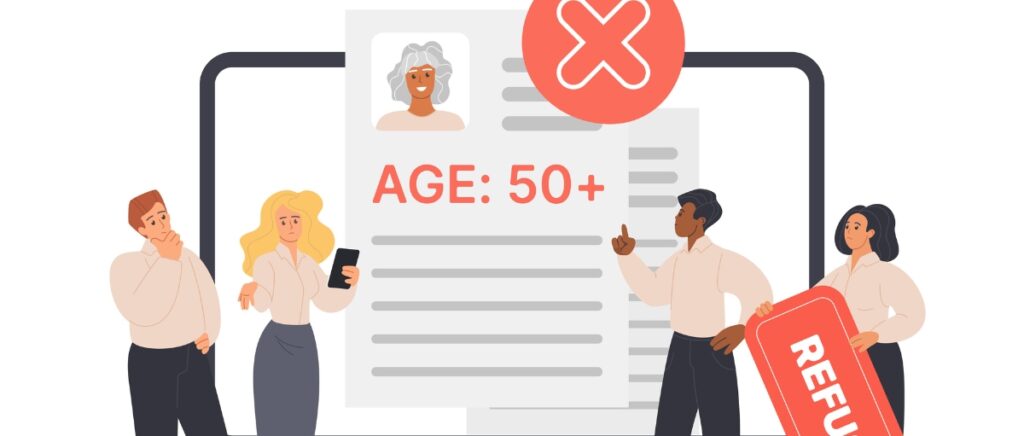If you’re over 40, you’ve likely felt the sting of ageism at work. You’re not alone. In 2018, AARP reported that 61% of adults over 40 have seen or experienced age discrimination in the workplace, and 38% of them believe it’s “very common.”
Age discrimination can take many forms, some subtle and some more blatant. Offhand comments about your age, getting passed over for opportunities, or pressure to retire early could all indicate that your workplace discriminates against older employees.
Knowing how to spot age discrimination is the first step to doing something about it. This article details the seven most common signs of ageism at work and what you can do if you’re experiencing discrimination. From hiring to firing and everything in between, learn how to identify illegal treatment and advocate for your rights as an older worker.
Age Discrimination is More Common Than You Think
Age discrimination isn’t just a rare occurrence – it’s a widespread reality for many older workers. Consider these alarming statistics:
- 90% of adults over 50 believe that age discrimination against older workers is common in the workplace.
- 26% of U.S. workers aged 50 and older report experiencing age-related remarks in the workplace over the past six months.
- One in five adults aged 50-plus (21%) report experiencing age discrimination since turning 40 years old.
These numbers paint a troubling picture of just how pervasive ageism is in the workplace. Across industries and occupations, older workers face bias and barriers due to their age. While age discrimination can happen in any job, it tends to be most rampant in fields like tech, media, and finance that worship youth culture and rapid change.
No one should have their years of experience and knowledge discounted or disrespected because of their age. Yet, for far too many workers, that’s exactly what happens. If you’ve felt the sting of ageism at work, you’re in good company – but that doesn’t make it right. Recognizing how common age discrimination is can empower you to spot the signs and take a stand against it.
Signs of Hiring Discrimination
Many experienced job seekers encounter age discrimination during the hiring process, which presents a significant barrier to employment. Prevalent ageist assumptions and practices within the job search process often impede qualified individuals from securing positions. Here are some of the most common signs that a prospective employer may discriminate based on age.
Ageist Job Descriptions
If you’ve read job postings with language like “seeking digital natives” or “recent graduates preferred,” you’ve encountered one of the sneakier forms of hiring discrimination. While these ads don’t directly mention age, they send a clear signal that older candidates need not apply. Other red flags include job descriptions emphasizing youth, energy, or being a “cultural fit” – all code for wanting younger workers.
Inappropriate Interview Questions
Once you land the interview, ageist assumptions can still shape the conversation. Beware of questions that prod into your age, like when you graduated college or your long-term career plans. While interviewers can ask about your professional background, fishing for clues about how old you are crosses a legal line. The Age Discrimination in Employment Act prohibits age discrimination against individuals aged 40 or older.
Other problematic interview practices include making comments about your age or the age of other employees, asking about your health, or bringing up retirement. All of these introduce age considerations that shouldn’t factor into the hiring decision.
Getting Passed Over
The most obvious sign of age discrimination in hiring is when an older, more qualified candidate loses the position to a less experienced, younger person. While there can be other factors at play, a pattern of hiring young for roles that don’t require youth is a major red flag.
If you suspect your age played a role in getting passed over, ask for feedback on why you weren’t selected. Vague answers about “going in a different direction” or “not being the right fit” could be code for age discrimination, especially if your experience and skills match the position.
No one should be made to feel “too old” to get hired. Recognizing signs of age bias in the job search process is the first step to advocating for yourself and finding an employer who values experience and ability over youth.
When Experience Becomes a Liability
Getting hired is only half the battle. Even once they’re on the job, older workers face age discrimination in the workplace that can stall their career growth and make work a hostile environment. These are some of the most common ways ageism manifests in the workplace:
Ageist Comments and Harassment
Inappropriate remarks and “jokes” about age are some of the most pervasive forms of discrimination at work. Comments about health, appearance, energy levels, or ability to learn new things can make older employees feel unwelcome and disrespected.
While one-off remarks alone aren’t illegal, a pattern of harassing behavior that creates a hostile work environment is. If you consistently face derogatory age-related comments, you don’t have to grin and bear it.
Unequal Professional Development
When it comes time to hand out promotions or high-profile assignments, are younger employees always first in line? Being passed over for advancement opportunities in favor of greener colleagues is a telltale sign of age discrimination.
The same goes for company-sponsored training and development programs. If your employer only invests in educating their millennial employees on the latest skills and technology, that sends a clear message about whose growth they value.
Unfair Performance Standards
Holding older workers to higher performance standards or harsher consequences is another way age discrimination rears its head. Some examples of age discrimination include:
- Requiring more documentation of work from older employees
- Nitpicking the performance of older employees while letting mistakes slide for younger ones
- Denying bonuses or raises to older staff who meet the same goals as younger colleagues
If any of these sound familiar, you may be experiencing age-based performance discrimination. Trust your gut – if you sense you’re being singled out or set up to fail because of your age, you could have a legal case.
When Downsizing Targets the Older Employees
Age discrimination often peaks when companies start downsizing. If you begin to notice any of these troubling patterns, your employer could be engaging in ageist layoff practices:
- Layoffs Target Older Workers: When layoffs target a disproportionate number of older employees, that’s a major red flag. Unless there’s a clear, performance-based reason that more seasoned staff are on the chopping block, age discrimination could be the actual cause.
- Replacing Old with Young: Are the older employees being laid off and replaced by younger ones in suspiciously similar roles? This bait-and-switch tactic, known as “youth movement,” is an underhanded way companies try to force out older workers without getting sued.
- Retirement Pressure: If your company starts offering voluntary early retirement packages or not-so-subtly encouraging older employees to retire, watch out. Pressuring older workers to leave before they’re ready is a form of age discrimination.
What’s the difference between age discrimination and harassment?
The line between age discrimination and harassment can be blurry, but in general:
- Discrimination refers to any negative employment action (like hiring, firing, or promotion decisions) based on age.
- Harassment involves offensive comments or conduct based on age that create a hostile work environment or lead to an adverse employment action.
While discriminatory practices and harassing behaviors often go hand-in-hand, harassment becomes illegal when it’s so frequent or severe that it creates an intimidating or offensive work environment.
Stand Up Against Age Discrimination
If you’re experiencing age discrimination at work, you have options. Here’s what you can do to protect yourself and fight back:
- Document every incident of discriminatory behavior, including dates, times, and witnesses.
- Report the discrimination to your HR department or supervisor in writing.
- File a complaint with the EEOC within 180 days of the discriminatory incident.
- Consult with an employment lawyer about your legal rights and options.
A survey conducted by AARP shows strong support for change, with 86% of adults aged 50-plus agreeing that older Americans should be protected from age discrimination. You have the right to a workplace free of ageist bias and harassment and don’t have to tolerate discrimination because of your age.
Turn Awareness into Action
Ageism has no place in the workplace yet remains all too common. By knowing the signs of age discrimination at every stage of employment, you can better advocate for yourself and other workers with valuable experience and wisdom to contribute, regardless of age.
If you suspect you’re facing discrimination because of your age, don’t suffer in silence. Document the behavior, report it through the proper channels, and seek legal counsel if needed. Standing up to ageism isn’t just about defending your career—it’s about paving the way for a more inclusive, equitable workplace for all.
Recognizing age discrimination is the first step. Taking action is the next. Together, we can create a world of work where no one is sidelined, harassed, or pushed out of their job because of the year on their birth certificate.
Sources
AARP. (2023). Multicultural work jobs study. AARP Public Policy Institute. https://www.aarp.org/pri/topics/work-finances-retirement/employers-workforce/multicultural-work-jobs-study/?CMP=RDRCT-PRI-OTHER-WORKJOBS-052118/
AARP Research. (2022). Workforce trends and age discrimination among older adults. AARP. https://www.aarp.org/research/topics/economics/info-2022/workforce-trends-older-adults-age-discrimination.html
Society for Human Resource Management. (2023). New SHRM research details age discrimination in the workplace. SHRM. https://www.shrm.org/about/press-room/new-shrm-research-details-age-discrimination-workplace
AARP Research. (2022). Workforce trends and age discrimination among older adults. AARP. https://www.aarp.org/research/topics/economics/info-2022/workforce-trends-older-adults-age-discrimination.html
U.S. Equal Employment Opportunity Commission. (2023). Age discrimination. EEOC. https://www.eeoc.gov/age-discrimination
AARP Research. (2022). Workforce trends and age discrimination among older adults. AARP. https://www.aarp.org/research/topics/economics/info-2022/workforce-trends-older-adults-age-discrimination.html











